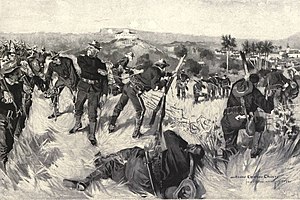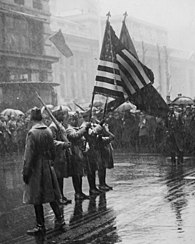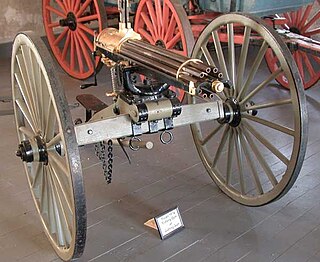
The Gatling gun is a rapid-firing multiple-barrel firearm invented in 1861 by Richard Jordan Gatling. It is an early machine gun and a forerunner of the modern electric motor-driven rotary cannon.

William Rufus Shafter was a Union Army officer during the American Civil War who received America's highest military decoration, the Medal of Honor, for his actions at the Battle of Fair Oaks. Shafter also played a prominent part as a major general in the Spanish–American War. Fort Shafter, Hawaii, is named for him, as well as the city of Shafter, California and the ghost town of Shafter, Texas. He was nicknamed "Pecos Bill",inspiration for the fictional character of the same name in tall tales.

The Rough Riders was a nickname given to the 1st United States Volunteer Cavalry, one of three such regiments raised in 1898 for the Spanish–American War and the only one to see combat. The United States Army was small, understaffed, and disorganized in comparison to its status during the American Civil War roughly thirty years prior. Following the sinking of USS Maine, President William McKinley needed to muster a strong ground force swiftly, which he did by calling for 125,000 volunteers to assist in the war. The U.S. had gone to war in opposition to Spanish colonial policies in Cuba, which was then torn by a rebellion. The regiment was also nicknamed "Wood's Weary Walkers" for its first commander, Colonel Leonard Wood. This reflected their dissatisfaction that despite being cavalry, they ended up fighting in Cuba as infantry, since their horses were not sent there with them.

The Battle of San Juan Hill, also known as the Battle for the San Juan Heights, was a major battle of the Spanish–American War fought between an American force under the command of William Rufus Shafter and Joseph Wheeler against a Spanish force led by Arsenio Linares y Pombo. The battle proved to be one of the most significant battles of the war and, along with the Siege of Santiago, a decisive battle in deciding the fate of the United States Army campaign in Cuba. The American forces, outnumbering the Spanish defenders 16-to-one, charged upon the heights and dispersed the Spanish after suffering heavy casualties.

The Battle of Las Guasimas of June 24, 1898 was a Spanish rearguard action by Major General Antero Rubín against advancing columns led by Major General "Fighting Joe" Wheeler and the first land engagement of the Spanish–American War. The battle unfolded from Wheeler's attempt to storm Spanish positions at Las Guasimas de Sevilla, in the jungles surrounding Santiago de Cuba, with the 1st U.S. Volunteer Cavalry and the 10th Regular Cavalry.

The Puerto Rico campaign was the American military sea and land operation on the island of Puerto Rico during the Spanish–American War. The offensive began on May 12, 1898, when the United States Navy attacked the capital, San Juan. Though the damage inflicted on the city was minimal, the Americans were able to establish a blockade in the city's harbor, San Juan Bay. On June 22, the cruiser Isabel II and the destroyer Terror delivered a Spanish counterattack, but were unable to break the blockade and Terror was damaged.

The siege of Santiago, also known as the siege of Santiago de Cuba, was the last major operation of the Spanish–American War on the island of Cuba.

Henry Ware Lawton was a U.S. Army officer who served with distinction in the Civil War, the Apache Wars, and the Spanish–American War. He received the Medal of Honor for heroism during the American Civil War. He was the only U.S. general officer to be killed during the Philippine–American War and the first general officer of the United States killed in overseas action. The city of Lawton, Oklahoma, takes its name from General Lawton, as does a borough in the city of Havana, Cuba. Liwasang Bonifacio in downtown Manila was formerly named Plaza Lawton in his honor.
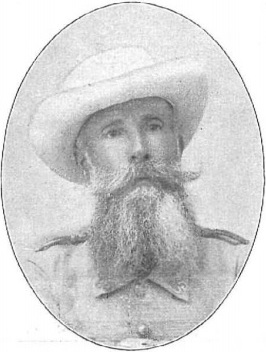
Joaquín Vara de Rey y Rubio was a Spanish military officer. He is best known for leading the tenacious defense of El Caney against a massively superior American force during the Spanish–American War.

The Battle of the Aguadores was a sharp skirmish on the banks of the Aguadores River near Santiago de Cuba, on 1 July 1898, at the height of the Spanish–American War. The American attack was intended as a feint to draw Spanish defenders away from their nearby positions at San Juan Hill and El Caney, where the main blows fell later that day.

The timeline of events of the Spanish–American War covers major events leading up to, during, and concluding the Spanish–American War, a ten-week conflict in 1898 between Spain and the United States of America.

Infanta María Teresa was the lead ship of her class of armoured cruiser constructed for the Spanish Navy. The ship fought at the Battle of Santiago de Cuba during the Spanish–American War.

Allyn Capron, was a captain in the United States Army. He commanded an artillery battery during the Wounded Knee Massacre.

The Bombardment of San Juan, or the First Battle of San Juan, on 12 May 1898 was an engagement between United States Navy warships and the Spanish fortifications of San Juan, Puerto Rico. It was the first major action of the Puerto Rican Campaign during the Spanish–American War.

John Henry Parker aka "Gatling Gun Parker" was a brigadier general in the United States Army. He is best known for his role as the commander of the Gatling Gun Detachment of the U.S. Army's Fifth Army Corps in Cuba during the Santiago campaign in the Spanish–American War.
The following units and commanders of the U.S. and Spanish armies fought at the Battle of San Juan Hill during the Spanish–American War on July 1, 1898.

The site of the Santiago Surrender Tree, located in Santiago, Cuba, marks the site where Spanish forces surrendered to U.S. forces on July 17, 1898, at the end of the Spanish–American War.

Major General Edward Mann Lewis, KCMG, was a highly decorated United States Army officer who served his nation for 46 years. During the First World War, he led the 30th Infantry Division when they broke the Hindenburg Line. Upon arrival in France in 1917, he was placed in command of all U.S. forces in Paris. In 1918 he led the 3rd Brigade of the 2nd Infantry Division at Château-Thierry where he was responsible for planning and leading the attack on the strategic town of Vaux. General John J. Pershing then promoted him and placed him in command of the 30th Infantry Division in July 1918. Assigned to the Fourth British Army, the 30th Division broke the Hindenburg Line on September 29, hastening the end of the Great War.
The 2nd Massachusetts Volunteer Infantry Regiment was an infantry unit of the United States Army, mustered into Federal service during the Spanish–American War.
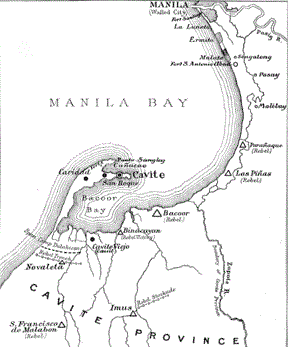
The Battle of San Roque was fought during the Philippine-American War between the United States and the First Philippine Republic. The battle resulted in the Filipinos being pushed off the causeway near San Roque, and forcing them to abandon their planned attack upon Cavite City itself.
